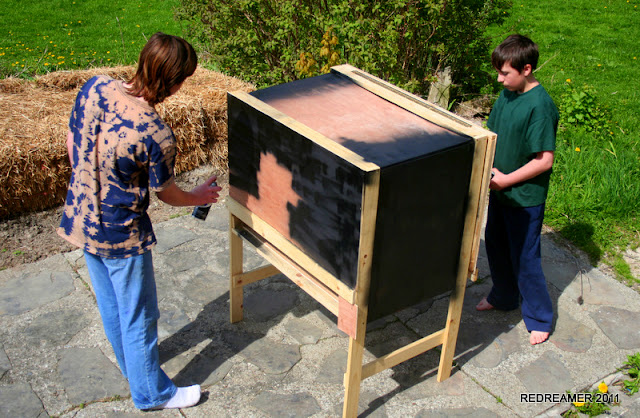Half way there making the tubes out of the cans. Ours measured 8 cans per tube and we made 12 tubes..... and we ended up only needing 11 because we forgot in our estimating to allow for the intrusion of the wooden frame INSIDE the outer edge of the polycarbonate sheeting. So 88 cans in total for the whole project... collected slowly over winter... total cost.... well less than $5 if we had returned them for recycling.
ALL the cans arranged inside the frame.
Drew putting on the back of the box..... cut to the same size we reused some old plywood paneling,
Jye hammering the small nails onto the back to attach the plywood to the frame it took a bit of concentration and the nails were small.
Drew adding nails to the back too. Pretty deft with the hammer.
Here the boys are using hand files to take off any burrs left behind after cutting out the holes with the hole saw. Cutting out the holes with a cordless (WITH a fully charged battery) took a little while but we measured out the spacing and cut them out... going through BOTH fully charged batteries to do the 11 holes. It would have been better to do it using a corded drill ... but the only one we have would risk wrist wrenching its a little too powerful for the job and hole saw bits can grab unexpectedly so it was a trade off of speed for safety.
We took it outside even though it was too cold for the paint to dry .... just for the application and because of
fumes. We left it to get tacky dry then moved it under the back veranda roof in case it rained.
Next Step is to add the polycarbonate cover and the base plate....which means another 11 holes to drill tomorrow which will be the last major task..... we had to wait for drills to recharge but all in all it was a productive day. The cold damp weather is making drying of glue a little longer than might have been usual.... today it was 33f ALL DAY.
and today we added the polycarbonate top and the air out frame.
We are VERY VERY happy with this result....... Now to build the cabinet for the dehydrating.... Stay tuned.



























